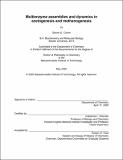Multienzyme assemblies and dynamics in acetogenesis and methanogenesis
Author(s)
Cohen, Steven E.,Ph. D.Massachusetts Institute of Technology.
Download1192923877-MIT.pdf (45.39Mb)
Other Contributors
Massachusetts Institute of Technology. Department of Chemistry.
Advisor
Catherine L. Drennan.
Terms of use
Metadata
Show full item recordAbstract
The Wood-Ljungdahl pathway of acetogenesis allows for growth utilizing carbon dioxide as the sole carbon source. This process uses a series of metalloenzymes to catalyze the reduction of two molecules of carbon dioxide to acetyl-CoA. Key to this pathway are the bifunctional carbon monoxide dehydrogenase/acetyl-CoA synthase (CODH/ACS) and corrinoid iron-sulfur protein (CFeSP). CODH/ACS is a bifunctional enzyme, with the CODH subunit catalyzing the reduction of carbon dioxide to carbon monoxide. CFeSP is a cobalt-containing corrinoid-dependent methyltransferase. The active site of ACS, termed the A-cluster, is a nickel, iron, and sulfur-containing metallocluster which catalyzes the synthesis of acetyl-CoA from carbon monoxide provided by CODH, a methyl group provided by CFeSP, and CoA. Despite the unprecedented organometallic chemistry performed at the A-cluster much is unknown about this ACS activity. No substrate-bound structures of ACS have ever been reported and the molecular basis for ACS and CFeSP interactions are largely uncharacterized. Here we present the structure of the carbonylated A-cluster in CODH/ACS, highlighting the role of conformational dynamics in catalysis. We further characterize ACS dynamics using negative-stain electron microscopy, demonstrating a much larger extent of conformational flexibility than has been crystallographically observed. The basis for CFeSP:ACS interactions is further interrogated using a series of CFeSP domain constructs, showing the corrinoidbinding Rossmann fold to be sufficient for ACS interactions. Finally, we report preliminary structural characterization of acetyl-CoA decarbonylase/synthase (ACDS), a 2.2 MDa complex of CODH, ACS, and CFeSP found in archaeal methanogens. Together, this advances our understanding of the roles of structure and dynamics in the Wood-Ljungdahl pathway.
Description
Thesis: Ph. D., Massachusetts Institute of Technology, Department of Chemistry, May, 2020 Cataloged from the official PDF of thesis. Vita. Includes bibliographical references.
Date issued
2020Department
Massachusetts Institute of Technology. Department of ChemistryPublisher
Massachusetts Institute of Technology
Keywords
Chemistry.